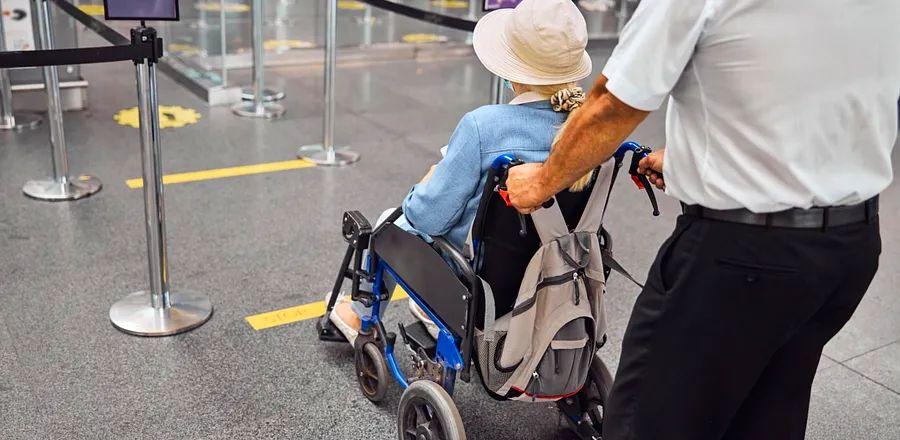Airlines Are Gradually Adopting Inclusivity and Accessibility. Here’s What to Know.

For many travelers, flying can be a source of anxiety, but for others, the in-flight experience can be particularly challenging or even traumatic. For those who identify as neurodivergent, disabled, or gender nonconforming, air travel often involves navigating a landscape filled with microaggressions and obstacles—like being unable to board with a wheelchair or mobility aid, being referred to by a birth name that no longer applies, or struggling to find your way around the cabin.
Fortunately, airlines have been progressively stepping up to address these issues over the last few years, adopting new policies that make flying a bit more welcoming and streamlined. Here are five encouraging advancements.
JetBlue Enhances Its Seatback Experience for Gender Inclusivity
Leading the way in in-flight entertainment, JetBlue introduced new seatback screens named Blueprint by JetBlue this spring, designed to provide personalized content for travelers. Among its standout features—including a “watch party” option and the ability to save preferences—JetBlue will allow passengers to customize their welcome messages on the seatback screens. Rather than being greeted by their legal first name, travelers will soon have the option to choose a name that reflects their identity, offering a small but significant gesture for those who are transgender or nonbinary.

Courtesy of Delta Flight Products
Delta is creating an innovative seat specifically for wheelchair users
Delta Flight Products, a division of Delta Air Lines, has recently introduced a new seat design that enables travelers who use a wheelchair to bring their wheelchair onboard and remain seated in it throughout the flight. This groundbreaking prototype was developed in collaboration with U.K.-based Air4All, specialists in accessible aircraft seating, and was showcased last year at the Aircraft Interiors Expo in Hamburg, Germany.
The patented design allows airlines to maintain their cabin seating arrangements by transforming a standard passenger seat into one that can securely hold a wheelchair restraint. Additionally, it ensures that passengers using wheelchairs have access to a headrest and an adjustable center console tray table that can be positioned once the wheelchair is in place.
Currently, wheelchair users must navigate a challenging process to get through the airport and into their airplane seat. After checking in their wheelchair, they are transported to the gate using an airline-provided wheelchair service. Once there, they are transferred to their seat, remaining in their wheelchair for the entire flight. This product is still in the early stages of development, with a Delta spokesperson informing Dinogo last year that approximately 18 months of work and reviews are needed before it can be implemented on planes.

Courtesy of United Airlines
United is incorporating Braille signage throughout its fleet
Last summer, United Airlines announced it had begun adding Braille signage to its planes, becoming the first U.S. airline to implement accessible signage on its aircraft. The markings indicate individual rows and seat letters on overhead compartments and are also present inside and outside the restrooms. The airline aims to equip its entire fleet with Braille by 2027.
For its new signage, United collaborated with the National Federation of the Blind, the American Council of the Blind, and various disability advocacy organizations to identify optimal locations for Braille to assist visually impaired customers.
"The flying experience can often be challenging for blind individuals for several reasons, including the reliance on printed signs and visual cues for information," stated Mark Riccobono, president of the National Federation of the Blind. The organization aims to keep partnering with United to discover further ways to make air travel more accessible and less stressful for blind passengers.
United launched an innovative search feature for wheelchair users
Recently, United Airlines introduced a new search filter on its website and app designed to enhance equity for travelers with mobility devices. This tool allows customers to enter the precise dimensions of their wheelchair, and then the site displays all available flights between their departure and destination that can accommodate and safely transport their wheelchair, as cargo hold sizes differ and not all can accommodate larger motorized chairs.
"By providing customers with an effortless way to determine if their personal wheelchair will fit on a specific aircraft, we can offer them the reassurance they need when flying with us," said Linda Jojo, United's executive vice president and chief customer officer. "Additionally, gathering this information in advance allows our team to handle these special items with the necessary care and attention."
If the aircraft for a traveler’s chosen route isn’t suitable for their wheelchair, United allows travelers to book an itinerary that accommodates their mobility device. The airline will refund the fare difference if the new option is pricier, provided both flights are on the same route and date. Travelers must complete a form post-flight to receive the reimbursement.

Image courtesy of Turkish Airlines
Airlines are supporting travelers with invisible disabilities
In recent years, airlines such as Turkish Airlines, Air New Zealand, and British Airways, along with over 240 airports globally, have collaborated with the Hidden Disabilities Sunflower organization to enhance travel accessibility for individuals with mental and physical challenges that may not be visible. Anyone identifying with an unseen disability—such as chronic pain, diabetes, dementia, autism, brain injuries, ADHD, dyslexia, joint issues, mental health conditions, or sleep disorders—can request a sunflower-decorated lanyard, which is a recognized symbol for nonvisible disabilities.
The lanyard is designed to discreetly inform cabin crew and ground staff that a passenger may need extra assistance during their journey, such as help with navigating the terminal or additional time for boarding and disembarking, all without drawing unnecessary attention to their hidden disability. The organization aims for this initiative to foster a more accessible and comfortable travel experience, reducing stress for passengers.
Evaluation :
5/5



